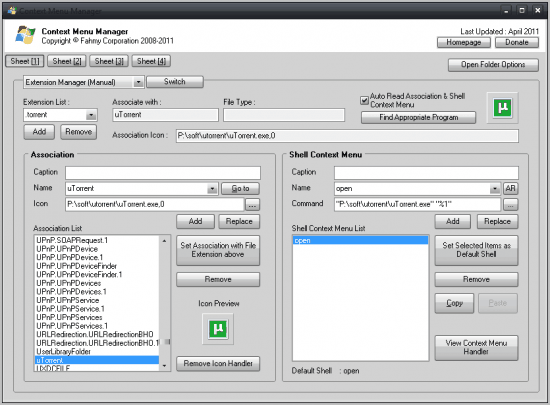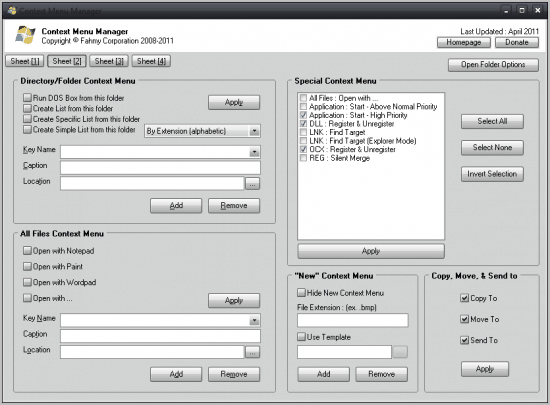Getting Windows to start the right program on double-click can be quite the daunting task. Not that it is usually that difficulty to link a file extension to a default program, but sometimes, it just does not stick. For me, it is a month long problem with torrent files that display the open with dialog even though I have selected a default program.
What can you do to resolve those file association issues? You can either try to resolve the issue by uninstalling and installing applications again, start editing the Windows Registry, or use a program like Context Menu Manager which makes the configuration process more comfortable.
The portable software displays all file extension management options on the first screen after it has been started. You select a file extension from the Extension List drop down menu to change file associations and shell context menu entries. New file types can be added, and existing ones removed for a clean start.
One interesting option here is the option to find the best suitable program for the file type. This is done with a click on Find Appropriate Program which opens a Microsoft website in the default Internet browser.
You can make changes to the default file association of the program, for instance to switch from one program to a new one that you have installed or available on the computer. Context menu entries can be removed, added or edited.
The Windows application links to three additional pages that offer more context menu related features.
You can add new context menu entries on page two, for instance to run a program with a different priority setting, or to register or unregister dynamic link libraries and ocx files.
There are also options to run a dos box from the active folder, add new open with links or to add copy, move and send to commands to the context menu.
The features offered on the second page can extend the functionality of the context menu further.
I’m not really sure about the purpose of the My Extension Manager on page three of the program. My guess is that it can be used to configure alternative programs for specific file extensions, in a similar manner as the portable software eXpresso does.
You can add file extensions and parameters on the page that can then supposedly be opened with the selected application.
This demonstrates one of the weaknesses of the program. There is no help or documentation which may leave you guessing at times what a specific feature does.
The fourth and final page can add context menu items to the My Computer context menu. From changing the computer’s state to adding links to Windows control panel applets and basic tools. It is all there and selectable.
Context Menu Manager is a solid program that is very effective when it comes to editing, adding or removing context menu items and default program associations. The software has been tested on a 64-bit edition of Windows 7. Downloads are provided at the developer website (linking to download portals). I have tested the program on Virus Total and it turned out to be clean. I suggest you do the same before you run it for the first time.
© Martin Brinkmann for gHacks Technology News | Latest Tech News, Software And Tutorials, 2011. | Permalink | Add to del.icio.us, digg, facebook, reddit, twitter
Post tags: context menu, context menu manager, portable software, windows software


Nenhum comentário:
Postar um comentário